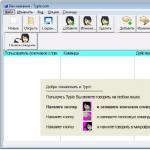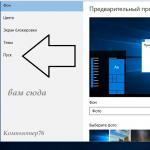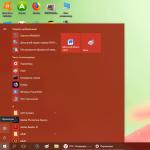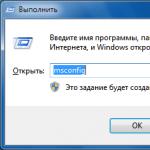The idea of how to save images from the Windows 10 lock screen came to me after I saw some really beautiful images. I began to search and understand in this direction, and I succeeded. I think that you will also be interested to know this, since many of the pictures (images) there can really be considered masterpieces (my personal opinion). Today I will tell you how to do it.
How to Download Lock Screen Pictures in Windows 10
In fact, it is relatively simple and does not require any specific skills. Following a very simple instruction - you will definitely succeed!
Pressing keys on the keyboard Win+R and in the opened window Run» enter the following (you can just copy and paste there:
%LOCALAPPDATA%\Packages\Microsoft.Windows.ContentDeliveryManager_cw5n1h2txyewy\LocalState\Assets
And press " Enter” or simply click the button “ OK«.

Here are our pictures. They are without extension. In order not to break anything here, you need to select all the files and copy them to any other directory. For example, create a folder on the desktop called "win10_lockscreen" and copy all these files there.
Now we need to set the extension " jpg“In order not to rename each file separately, we will do it in bulk.
After copying, open this folder, CLAMPING button SHIFT on the keyboard and press PKM (right click) in any free space in the folder. In the context menu that appears, select " Open command window»

In the command line window that opens, enter:
Ren *.* *.jpg
and press " Enter»

That's all. Now these files can be easily viewed by photo viewers.

Conclusion
Maybe this is not the only way to get pictures from the Windows 10 lock screen, then this method is quite a working one. If you know another method of how to do this, write in the comments and we will definitely add it here to the instructions.
If something doesn’t work out for you, write, we’ll try to figure it out together.
Setting the desktop wallpaper is a fairly simple topic, almost everyone knows how to put wallpaper on the Windows 10 desktop or change it. All this, although it has changed compared to previous versions of the OS, but not in such a way that it could cause significant difficulties.
But some other nuances may not be obvious, especially for novice users, for example: how to change the wallpaper on an unactivated Windows 10, set up automatic wallpaper change, why photos on the desktop lose quality, where they are stored by default, and is it possible to make animated wallpapers on Desktop. All this is the subject of this article.
How to set (change) desktop wallpaper Windows 10
The first and simplest is how to install your picture or image on your desktop. To do this, in Windows 10, just right-click on an empty spot on the desktop and select the "Personalization" menu item.
In the "Background" section of personalization settings, select "Photo" (if the choice is not available, since the system is not activated, information on how to get around this is below), and then - a photo from the proposed list, or by clicking on the "Browse" button, set own image as desktop wallpaper (which can be stored in any of your folders on your computer).

Among other settings, the wallpapers have Width, Stretch, Fill, Fit, Tiling, and Center layout options. If the photo does not match the resolution or screen proportions, you can bring the wallpaper to a more pleasant look using the options indicated, but I recommend just finding a wallpaper that matches the resolution of your screen.
The first problem may immediately await you: if not everything is in order with the activation of Windows 10, in the personalization settings you will see a message stating that “To personalize your computer, you need to activate Windows.”

However, in this case, you also have the option to change the desktop wallpaper:
So, even if your system is not activated, you can still change the desktop wallpaper.
Automatic wallpaper change
Windows 10 supports desktop slideshows, i.e. automatic change of wallpaper among the ones you choose. In order to use this feature, in the personalization options, in the "Background" field, select "Slideshow".

After that, you can set the following options:
- The folder containing the desktop wallpaper that should be used (when selected, the folder is selected, i.e. after clicking "Browse" and entering the folder with images, you will see that it is "Empty", this is the normal operation of this function in Windows 10, contained wallpapers will still be displayed on the desktop).
- The interval of automatic wallpaper change (they can also be changed to the following ones in the right-click menu on the desktop).
- The order and type of location on the desktop.
Nothing complicated, and for some of the users who are bored of seeing the same picture all the time, the function can be useful.
Where is Windows 10 desktop wallpaper stored
One of the frequently asked questions regarding the functionality of desktop images in Windows 10 is where is the standard wallpaper folder on the computer. The answer is not entirely clear, but for those interested it may be useful.
These are all the main locations where Windows 10 wallpapers are stored, except for the folders on your computer where you store them yourself.
Desktop wallpaper quality
One of the most common user complaints is the poor quality of desktop wallpapers. The reasons for this may be the following:
- Wallpaper resolution does not match your screen resolution. Those. if your monitor has a resolution of 1920x1080, you should use the wallpaper at the same resolution, without using the Width, Stretch, Fill, Fit to Size options in the wallpaper options settings. The best option is "Center" (or "Tile" for a mosaic).
- Windows 10 will re-encode wallpapers that were in great quality by compressing them to Jpeg in its own way, resulting in poorer quality. This can be bypassed, below is how to do it.
To ensure that when installing wallpapers in Windows 10, they do not lose quality (or lose not so much), you can change one of the registry settings that determines the jpeg compression settings.
- Go to the registry editor (Win + R, enter regedit) and go to the section HKEY_CURRENT_USER\ Control Panel\ Desktop
- By right-clicking on the right side of the registry editor, create a new DWORD value named JPEGImportQuality
- Double click on the newly created parameter and give it a value between 60 and 100, where 100 is the maximum image quality (no compression).
Close the Registry Editor, restart your computer or restart File Explorer and reinstall your desktop wallpaper so that it displays in good quality.
The second option to use high quality wallpapers on your desktop is to change the file transcoded wallpaper in C:\Users\username\AppData\Roaming\Microsoft\Windows\Themes your original file.
Animated wallpapers in Windows 10
The question about how to make a live animated wallpaper in Windows 10, put a video as a desktop background is one of the most frequently asked by users. There are no built-in functions for these purposes in the OS itself, and the only solution is to use third-party software.
From what can be recommended, and what definitely works, is the DeskScapes program, which, however, is paid. Moreover, the functionality is not limited to animated wallpapers. You can download DeskScapes from the official website http://www.stardock.com/products/deskscapes/
I conclude with this: I hope you have found something here that you did not know about desktop wallpapers before and that turned out to be useful.
Users of the Windows 10 operating system are very fond of the new interface, which impresses with its bright extraordinary pictures when you turn on your computer and lock the screen. Images automatically change every day, but the OS itself chooses the frequency of changing pictures during the screen lock. This does not always suit, and non-fast users want to adjust their settings.
Also, users are aware of cases when the OS itself installs the same image daily. Or two pictures out of a large number stop changing for a long time, and you have to wait until Windows 10 chooses a new picture itself. And you don't know when that will happen. This situation can be corrected in several simple ways on your own by changing the parameters in the system settings.
Lock screen
The easiest method is to select images from the list provided directly by the OS.
- You need to click on the camera icon on the PC / laptop monitor (upper right corner).
- Windows 10 will ask the question: "Did you like what you saw?" Answer "I don't like it."
- You will be presented with the following picture. Answer "Dislike" to all unsuccessful images.
- The operating system will independently select screensavers to your liking.
WINDOWS: interesting
In all versions of Windows 10, users have access to the informative Windows Discover service. It works in the following way: during the demonstration of images downloaded from the Internet, you can select the pictures you like and, conversely, select those that you don’t like. In the future, the OS will show you only the photos you like, as well as search for images on the Internet that match your interests.
The second method is a little more complicated, but the result will be much more interesting.

It is worth noting that all the images are interesting, beautiful and of high quality. To do this, OS developers select the best works of famous photographers and add them to their databases. Each user will be able to customize the photo sequence to their liking.
Replacing standard images with personal photo cards
In the same way, you can easily set your favorite photos on the lock screen of your PC / laptop. To do this, follow a few simple steps below.
.jpg)
We looked at the most common ways to change pictures on the PC / laptop lock screen. After completing all the steps step by step, you can easily change any images and photos whenever you want. You also learned about the additional options for customizing the interface of the tenth version of Windows, which will make working with a PC / laptop even more enjoyable for you and your whole family.
Personalization in Windows - customizing the design of the operating system to your individual (personal) tastes and needs. The user can change the theme, color, desktop background, sounds, screensaver, font size, avatar, etc. on his computer according to his preferences.
The combination of images, colors, sounds, splash screen is called a theme. Your computer already has themes ready to use, you can create and customize the theme as you wish.
In the article, we will get acquainted with the personalization settings in Windows 10, you will learn where you can download official Microsoft themes and wallpapers (backgrounds) for the Desktop, how to install or remove the theme from the computer, where the themes are stored on the computer, how to extract the desired image from the theme.
Personalization settings can be accessed from the Start menu. Select Options and then Personalization. It’s even easier to enter the settings as follows: right-click on a free area of the monitor screen, and select “Personalization” from the context menu.
Personalization in Windows 10
In the "Personalization" window, in the "Background" tab, select an image for the desktop background. The following options are available for displaying the background:
- Photo - the background is a separate image.
- Solid color - the selected color will be used as the background.
- Slideshow - background images will change at regular intervals.
When choosing one of the options, you will need to make settings: select a photo, select a background color, select albums for a slide show. In each case, select the desired settings. Here you can select the position of the background: "fill", "fit", "stretch", "tesse", "center", "expand".
In the "Colors" tab, select the main color for the design of Windows. In the settings, you can enable automatic selection of the main background color, change the color display options in the Start menu, on the Taskbar and in the Action Center.

In the "Lock screen" tab, you can configure the background that will be displayed on the monitor screen when the computer is locked. There is a choice of three options for displaying the background of the lock screen: "Windows: Interesting", "Photo", "Slideshow".

From the "Themes" tab, you go to the theme options, and related options: "Advanced sound options", "Desktop icon options", "Mouse pointer options".

We will discuss the theme options in more detail later. If necessary, adjust the sound settings, mouse pointer settings. Enter the desktop icon settings.
In the Desktop Icon Options window, select the icons you want to display on the desktop, and then click the OK button. To remove an icon from the Desktop, uncheck the box next to the corresponding icon, and then click on the "OK" button.

In the "Start" tab, you can configure the parameters of the "Start" menu. The user himself selects the settings according to his preferences: the number of tiles displayed, the display of recommendations, the order in which applications are displayed, etc.

Saving a Theme in Windows
Open the Themes tab, click on Theme Options. This will open the Personalization window. Here you will see the default themes and themes you have added. Windows 10 comes with three default themes: Windows, Windows 10, Flowers. To activate a theme on your computer, click on the relevant theme.
If the theme is named Unsaved Theme, click the Save Theme link to save and name the theme.

How to download Microsoft themes
Users find desktop themes and wallpapers on the Internet, many do not even suspect that you can download Microsoft themes and wallpapers from the official website of the corporation. Official themes and wallpapers can be found on the Personalization Gallery page. In the personalization gallery you will find themes, desktop backgrounds, language packs.
The site has a wide range of topics. Topics are grouped into categories: Animals, Art (Drawings), Art (Photos), Automobiles, Games, Holidays and Seasons, Movies, Natural Wonders, Places and Landscapes, Plants & Flowers, Branded Themes, Community Based, Panoramic (Dual Monitors), Custom Sounds, Compatible with Windows 7, Compatible with New Windows.
You can download and install any theme from this collection on your computer. Windows 7 users can download and install on their computer many of the themes from the Microsoft Gallery that support this operating system.

Enter the relevant collection, select a topic, click on the "More" link. Here you will see detailed information about the topic: the number of images in this topic, the color of the window, an example image on the computer screen. View all the images included in the theme, if the theme suits you, download the theme to your computer.

How to delete a theme in Windows
If you no longer need this theme, you can delete the theme from your computer. The theme to be deleted must not be active at the time of deletion. Hover your mouse over a topic, right-click on the topic, and then click on Delete Topic.
How to download Microsoft wallpapers
In the Personalization Gallery window, go to the Desktop Backgrounds tab. Wallpapers (backgrounds) are combined into image collections: Animals, Art (drawings), Art (photos), Cars, Games, Holidays and seasons, Natural wonders, Places and Landscapes, Plants & Flowers, Signature Wallpapers, From Community, Panoramas, All Wallpapers.

After clicking on the image, the image will expand. You can save the image you like to your computer to use as your desktop background.
Any image can be used on a computer as desktop wallpaper. To do this, right-click on the image, and select "Set as desktop background image" from the context menu.
Where are Windows 10 themes stored?
The default themes are stored on your computer in the "Web" folder. In order to get to this folder, go to the following path (the standard Windows 10, Windows 8.1, Windows 8, Windows 7 desktop wallpapers are stored in this place):
C:\Windows\Web
In the "Web" folder, you will find three folders: "4K", "Screen", "Wallpaper". The 4K folder contains the official Windows 10 splash screen in various resolutions. The "Screen" folder stores the images used for the lock screen splash screen. The "Wallpaper" folder contains folders with three official themes, which store images that are part of these themes.
If you like a particular image from a theme and want to use that image as your desktop background, you can copy the image to another location and then make that image your desktop background.
Self-downloaded themes on your computer are stored elsewhere. There are two ways to extract a single image from such a topic.
First way. Unpack the downloaded but not yet installed theme on your computer using an archiver, such as WinRAR or 7-Zip. In the folder you will find all the images included in the theme.
The second way. You will find images that are part of a theme already installed on your computer in a folder named after the theme, which is located in the following path:
C:\Users\username\AppData\Local\Microsoft\Windows\Themes\
Where is the lock screen wallpaper stored
You can find standard lock screen background images in the Screen folder. If the Windows: Interesting option is selected in the lock screen background settings, then the Windows 10 operating system downloads images from the Internet to the computer. These images can be used not only as a lock screen saver, they can be used as a desktop background.
The downloaded images that are used as the background of the lock screen are in this path:
C:\Users\username\AppData\Local\Packages\Microsoft.Windows.ContentDeliveryManager_cw5n1h2txyewy\LocalState\Assets
The Assets folder contains files downloaded to your computer. Copy the file from this folder to a convenient location on your computer. Next, rename the file, give the file some name with a ".jpg" extension, such as "picture.jpg".
After that, you can use this image as your desktop background.
Article Conclusions
The user can customize the design of the Windows 10 operating system to suit their individual needs. These settings are called personalization. From the official site, you can download and install Microsoft themes and wallpapers on your computer. You can use any image included in the theme as your desktop wallpaper.
Personalize Windows 10 How to download Microsoft themes and wallpapers (video)
When you turn on or turn off your computer, lock screen, where notifications of various applications are displayed on a beautiful background. This is one of the few visual components that have moved into the top ten from the previous version of the system. The lock screen does not carry any special functionality, so it can be disabled without any consequences for Windows. How to disable (enable) and change (customize) the lock screen, including through the new "Windows: Interesting" (Windows Spotlight) - read further after the button of the same name.
How to disable (enable) the lock screen inWindows 10
There are two ways to turn off the lock screen in Windows 10: Using the Local Group Policy Editor gpedit.msc and by editing the registry. We will go the second way, because. in some versions of the OS, the policy editor is not available.
So to disable lock screen press the key combination " Win+R" and type regedit → "OK" → in the registry editor, expand the chain HKEY_LOCAL_MACHINE\SOFTWARE\Policies\Microsoft\Windows\Personalization → in the last section create " DWORD Value (32-bit)" under the name NoLockScreen and also through the right mouse button set the value to " 1 " (screenshot below). If the section Personalization if you don't have it, you'll have to create it manually.

To enable lock screen perform the above manipulations with the system registry by setting the value of the parameter NoLockScreen equal " 0 " → "OK". Changes will take effect immediately, but to check if the option works, click " Win + L" (change user or lock the system), or better, restart the PC.
Customize your lock screenWindows 10

Starting with Windows 8, Microsoft's "OS" has learned to add your favorite images (background, photo) of nature, relatives and friends, plus, create a cyclic slide show. In order to customize lock screen through " Start"select" Options" → next " Personalization" → "Lock screen". The current background will be shown on the right side of the window, while some of its options will appear as tiles below. Review" to select from the entire collection of images. In addition:
- for a slide show, tap the drop-down menu of the "Background" subcategory and stop at " Slide show" → select folders containing photos of the desired resolution (advanced settings are hidden under the link " More slideshow options");
- about the "Windows: Interesting" mode (screenshot), which was released with the release of the Threshold 2 batch update, read the details in the third part of the presented review.
How to change the image (background) of the Windows Spotlight lock screen
After the announcement of the last November update of the latest version of Windows, users have the opportunity to see the lock screen in the style Windows Spotlight("Windows: interesting"), "smart" lockscreen (Eng. lrockscreen), which is not limited to providing the usual information - time, date and reminders. Using machine learning algorithms, Spotlight shows various applications that he thinks can increase your productivity. According to the same principle, in compliance with the taste of the user, background images are selected that are loaded from Microsoft servers.
To open them with any graphic viewer (editor)/ rename / delete / move to another folder:

- open Explorer and enable the display of hidden elements on the "View" tab (screenshot);
- paste the path into the address bar of Explorer C:\Users\ [Your_Account_Name] \AppData\Local\Packages\Microsoft.Windows.ContentDeliveryManager_cw5n1h2txyewy\LocalState\Assets → "Enter";

- in the folder assets, by clicking on the file and pressing the " F2 ", rename all files as shown in the pre-final screenshot.

Now you know where lock screen images are stored Windows 10 when you turn on the "Windows: interesting" mode, and the small thing is to set up the system "for yourself", according to personal preferences and taste.




